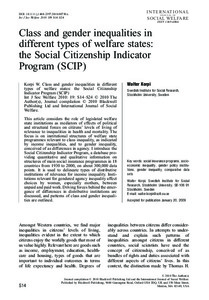Class and gender inequalities in different types of welfare states: the social citizenship indicator program (SCIP)

International Journal of Social Welfare
2010
19
S1
14-24
comparison ; international ; welfare state ; social inequality ; gender equality
Social protection
English
Bibliogr.;[Internet download]
"This article considers the role of legislated welfare state institutions as mediators of effects of political and structural forces on citizens' levels of living of relevance to inequalities in health and mortality. The focus is on institutional structures of welfare state programmes relevant to class inequality, as indicated by income inequalities, and to gender inequality, conceived of as differences in agency. I introduce the Social Citizenship Indicator Program, a database providing quantitative and qualitative information on structures of main social insurance programmes in 18 countries from 1930 to 2000, on about 300,000 data points. It is used to delineate types of distributive institutions of relevance for income inequality. Institutions relevant for gendered agency inequality affect choices by women, especially mothers, between unpaid and paid work. Driving forces behind the emergence of differences in distributive institutions are discussed, and patterns of class and gender inequalities are outlined."
Digital
The ETUI is co-funded by the European Union. Views and opinions expressed are however those of the author(s) only and do not necessarily reflect those of the European Union or the ETUI.